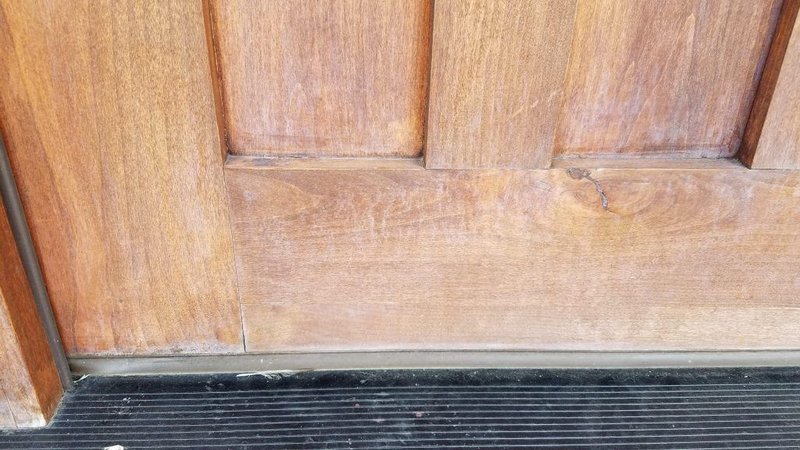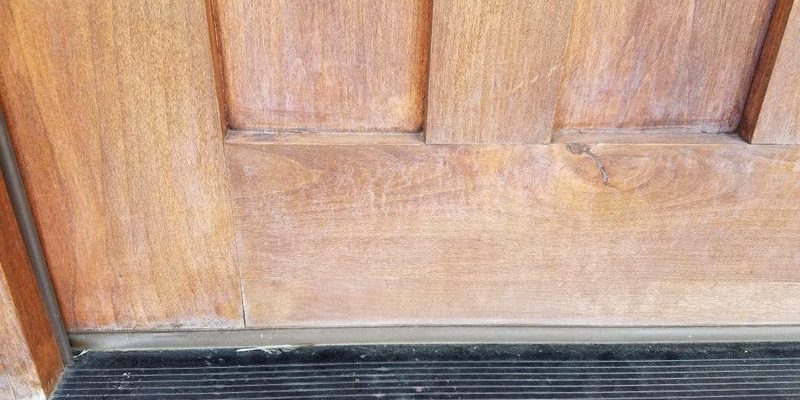
Honestly, protecting your door handles, deadbolts, and knockers isn’t just about looks either. UV damage can make hardware sticky, rough, or even brittle, which means your locks and latches can stop working smoothly. Whether you’ve got a fancy Schlage smart lock, a basic Kwikset latch, or a classic brass knocker, every brand and style is at risk. So, the question is: how do you keep your door hardware looking sharp and working right when the sun won’t quit? Let me walk you through the best ways to win this battle.
Why Does UV Damage Exterior Door Hardware So Much?
Here’s the thing: sunlight might look harmless, but those ultraviolet rays are powerful. When hardware is exposed all day, especially on south- or west-facing doors, the finish starts to break down. Most handles and locks come with protective coatings, but UV light can eat through even the toughest finishes over time. If you’ve ever seen peeling lacquer, weird chalky spots, or flaky paint on a doorknob, you’re looking at UV trouble.
Materials matter, too. Metal handles—think brass, bronze, nickel, or chrome—all react differently. Some alloys fade, others corrode faster. Even durable powder-coated finishes or stainless steel aren’t totally immune. Plastic or composite trims around electronic locks can warp or turn yellow. You might be surprised how a little sunlight can do so much damage.
It’s not just about looks, either. UV damage can wreck the smooth action of your hardware. Latches stick, springs weaken, and exposed screws rust out faster. If your key starts turning rough or your smart lock gets glitchy, the sun could be partly to blame. So, a bit of prevention really does go a long way.
Choosing UV-Resistant Exterior Door Hardware
Let me explain why starting with the right hardware makes a big difference. Not all door handles or locks are built for life in the sun. Some brands, like Schlage or Emtek, specifically rate certain models as UV-resistant or outdoor-durable. If you’re upgrading, look for products labeled “weather-resistant,” “marine grade,” or “UV protected.” These usually have extra-tough finishes designed to shrug off sunlight.
You might be wondering if material really matters that much. Absolutely! Stainless steel and solid brass hold up better than plated finishes or cheap alloys. Look for PVD (Physical Vapor Deposition) finishes—these create an ultra-thin, super-hard surface that’s far more resistant to fading and corrosion. Honestly, paying a little more for this up front beats having to replace faded, flaky hardware every few years.
It also helps to check the warranty. Some premium brands back their exterior finishes for decades—if not for life. That’s a good sign they’ve actually tested the hardware for real-world sun exposure, not just a few hours in a lab. Don’t just trust a pretty product photo; read the specs and the customer reviews before installing anything on your sunny front door.
Regular Cleaning: Your First Line of Defense
You might not realize it, but dust and grime speed up sun damage. When dirt builds up on hardware, it can trap moisture and intensify the effect of UV rays. That combo wears away the finish even faster. The best move? Wipe down your handles, locks, and levers every month—it doesn’t have to be fancy.
Here’s a simple routine that works for most brands:
- Mix a few drops of mild dish soap in warm water.
- Dampen a soft cloth (never use scouring pads!) and gently clean all exposed hardware, making sure to get around screws and under handle edges.
- Dry with a clean towel right after washing. Don’t let water spots settle in—minerals can leave stains that look just as bad as UV marks.
If you’ve got a keypad or smart lock, avoid getting water near electronics. Instead, use a barely damp cloth and follow up with a dry wipe. Regular cleaning not only looks good, it also gives you a chance to spot early signs of wear before things get ugly.
Applying Protective Coatings and Sealants
If you’re serious about extending the life of your exterior hardware, a little DIY protection goes a long way. Many homeowners swear by a coat of car wax or a dedicated metal polish with UV blockers. These products aren’t just for shine—they create a thin, invisible shield that repels sun and moisture.
Here’s how you can do it:
- Choose a non-abrasive wax or polish suitable for your hardware’s material. (Check the manufacturer’s care guide—some finishes need special products!)
- Apply a small amount to a microfiber cloth and rub it gently over the hardware, covering all exposed surfaces.
- Buff with a clean cloth for a subtle shine and stronger protection.
Do this every couple of months, especially after bad weather or heavy sun exposure. It’s quick and cheap insurance. If you have hardware with a clear lacquer that’s peeling, skip the wax and consider having the piece refinished by a pro—or replace it if it’s beyond saving. Trying to coat over damaged lacquer can make things worse.
Shade and Physical Barriers: Keeping the Sun at Bay
One of the most effective ways to protect your exterior door hardware from UV damage doesn’t involve any chemicals at all—just good old-fashioned shade. Adding a storm door, awning, or porch overhang can dramatically reduce the amount of direct sun your hardware gets every day.
For renters or folks on a tight budget, even a DIY door canopy or sunshade film can help. The less direct sunlight your lock or handle gets, the less wear and fading you’ll see. This is a game-changer for south-facing homes or spots that get hammered by afternoon sun.
You can also plant shrubs or install tall planters near your entryway—not right up against the door, of course, but close enough to filter some rays. Even a little bit of dappled shade can make a real difference in how fast finishes fade. And hey, your curb appeal gets a nice boost at the same time.
Routine Maintenance: Keeping Hardware Working Smoothly
It’s not just about surface looks—UV damage can actually mess with the moving parts inside your locks and handles. Springs dry out, lubricants evaporate, and plastic parts can become brittle. Regular maintenance is your friend here.
Here’s what works:
- Every 6–12 months, spray a little graphite or silicone lubricant into your keyhole and moving parts (but avoid using oils that attract dust).
- Check for any loose screws or wobbly handles—tighten them before the sun dries things out further.
- If you use smart or electronic locks, check battery compartments for signs of warping or fading, and replace batteries as needed. Sun-baked batteries lose charge faster.
If your lock starts sticking, don’t force it; that can cause more damage. Clean, lubricate, and reset the mechanism according to your manufacturer’s guide (and yes, most brands have those online for free). Consistent routine care keeps your hardware working as it should, even after years of sun exposure.
When To Repair or Replace UV-Damaged Hardware
Sometimes, no matter how careful you are, the sun wins. Look for signs like pitting, flaking, discoloration, and rough movement. If the finish is peeling off in sheets or metal is showing corrosion, it’s probably time for a change. Letting hardware stay damaged can lead to bigger problems—like condensation leaking into your lock or hardware failing at the worst time.
You might be able to repair minor sun damage by gently sanding and re-applying a clear sealant or spray lacquer. But for deeper wear, especially on keypads or multi-point locks, replacement is usually safer. Upgrading to a modern, UV-rated hardware set might save you tons of headaches in the long run. And honestly, a fresh handle or lock can be the finishing touch that pulls a whole entryway together.
If you’re worried about matching finishes when replacing, many brands now offer “universal” trim kits or smart remotes you can pair and code to existing locks. This makes upgrades much easier, without redoing your whole door.
Comparing Common Hardware Materials for UV Resistance
Not all metals and finishes handle the sun the same way. Here’s a quick look at how they stack up:
| Material | UV Resistance | Unique Needs |
| Stainless Steel | Excellent | Clean regularly, polish to restore shine |
| Brass (Solid or PVD) | Very Good | Needs regular waxing; lacquer can peel over time |
| Zinc/Alloy (Plated) | Fair to Poor | Fades and pits quickly; harder to repair |
| Powder-Coated Finishes | Good | Touch-up paint as needed; fade-resistant |
| Plastic/Composite | Poor | Prone to yellowing and cracking; limited repair options |
If you’re on the fence about which material to choose, go for solid metals with a proven UV-resistant finish. Plastic trims on electronic locks offer convenience but may need more frequent replacing in sunny spots.
Wrapping It Up: Making Your Hardware Last
Protecting exterior door hardware from UV damage isn’t complicated, but it does take some regular attention. Choose UV-resistant products, keep them clean, add protective coatings, and give them some shade when you can. A bit of routine maintenance makes sure your handles, locks, and keypads not only look good but work perfectly, sun or no sun.
Remember, a little prevention saves money and hassle down the road—and keeps your entryway looking sharp year after year. Whether you’ve got a Schlage, Kwikset, or something vintage from the hardware store, the sun doesn’t have to win. Give your exterior door hardware the care it deserves, and it’ll keep welcoming you home in style.
